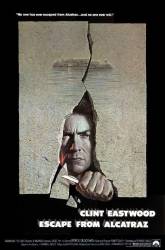Question: When Frank is delivering books to inmates' cells, he reaches D block, but a guard stops him, and tells him they are not allowed in those cells. Were books really disallowed in D block cells?
Question: Why was Wolf such a bully to Frank Morris?
Answer: This is a fictional account of a real-life event and the people depicted in it. Frank Morris was a vicious and dangerous criminal who, played by movie-hero Clint Eastwood, is made into a sympathetic figure. The Wolf character, who was probably not real or highly fictionalized, is contrived solely to create conflict in the plot by making him Morris' enemy. It also shows the constant danger and abuse from other prisoners.
Question: Why didn't the tower guards spot Frank, and the Anglin brothers while they were in the water?
Answer: Because, in the context of the story, they are in pitch blackness. It is common film practice to illuminate night scenes that would otherwise be in total darkness, for the obvious reason that the audience needs to see what is happening; however, as far as the characters are concerned, there is no such light.
I meant during the real escape.
Same reason - it was dark.
Question: The warden tells Frank Morris he is not permitted to have newspapers, or magazines carrying news. Why not?
Answer: In part, to break inmates. Alcatraz was notoriously tough on inmates, psychologically (although they did relax some of the strict rules by the 50s). In general, inmates had very little contact with the outside world, and many even had little contact with other inmates. In the film, the warden tells Frank the only news inmates get is what the warden tells them is the news.
Question: Why did the warden hate the fact that Doc painted a picture of him? Did he think he was mocking him?
Answer: There is no specific reason, the warden took away Doc's paintings. When he was in Doc's cell, retrieving his nail clippers, he saw the portrait of himself and had an amused smile, meaning he though it was pretty good.
Obviously, this is not the case as he would not have felt the need to take the painting, despite being an A-hole. The first answer is more likely correct, as he definitely felt mocked or ridiculed based on his actions.
Question: In the beginning of the movie when we see Frank Morris(Eastwood) getting out of the car and onto the boat,why wasn't he cuffed? The guards later cuff him when he is on the boat and would be difficult for him to escape.
Answer: I believe the director is trying to lure us into thinking that Eastwood is a good guy as he usually plays the hero. However that myth is shattered when he is cuffed.
Question: Why was Frank told to button his collar? And if it is a rule why did prisoners only button their top button when moving around the prison or meal times?
Answer: If I'm not wrong it was an actual rule in the prison and in the movie it shows how strict the prison is.
Answer: It is mostly a plot device that shows the growing antagonism between Morris and the warden. The warden develops a personal grudge against Morris and singles him out by particularly nitpicking and harassing him about any small infraction. It is meant to evoke sympathy for the fictionalized version of Frank Morris who, in real life, was an intelligent but dangerous criminal. Warden Dollison was a fictional character. Olin Blackwell was the actual Alcatraz warden at the time.






Answer: Those were the solitary confinement cells, with no light and no luxuries of any kind. So yes, they did not allow inmates on that block to have books.
This is inaccurate as a light in each cell was turned on at 6:30 every morning in solitary confinement at Alcatraz.